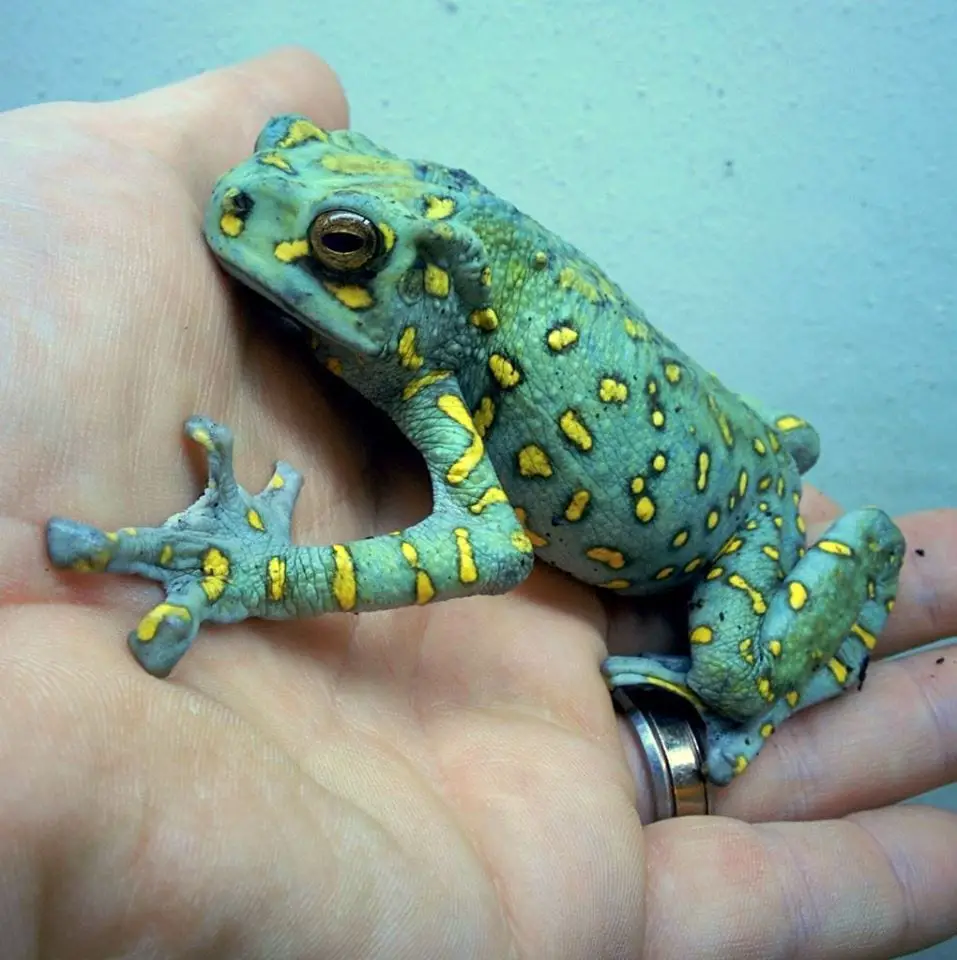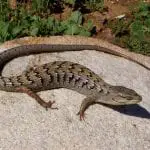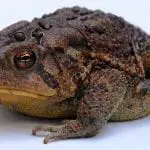Scientific Facts
| Common Name | Yellow Spotted Climbing Toad |
| Scientific Name | Rentapia hosts |
| Origin | Tropical and subtropical rainforest in Thailand, Borneo, Sumatra, Malaysia |
| Habitat | Forest near streams or other bodies of water |
| Diet | Adult crickets, hornworm, cockroaches, super worms, caterpillar, butterflies, moths, and wax worms |
| Size | Female: 5-5.5 inches Male: up to 3-4 inches |
| Lifespan | Wild: 5-10 years Captivity: up to 15 years |
Physical Description
During their juvenile years, Yellow Spotted Climbing Toads start off with brown colorations in the whole body with yellow stripes or patterns in the legs. As soon as they mature, the males tend to have an appearance of brown or yellow colorations in the whole body with faint yellow hints on the legs while the females tend to have a teal to blue or green body color with spots of yellow on their legs and in some parts of their body. The coloration of the females is more vibrant during the mating season. Males and females greatly differ in size and color; that is why you can easily distinguish which is which.
Where it is Seen?
This toad species hails from the tropical and subtropical rainforest in Thailand, Borneo, Sumatra, Malaysia. They are an arboreal species of toad that only stays in the forest near streams or other bodies of water.
Habitat
Yellow Spotted Climbing Toad originally lives in the water since after hatchlings, but as soon as they reach maturity, they move up in the trees. You often see them on the grounds when the mating season is about to start or when it is time to look for prey.
Behavior and Temperament
Yellow Spotted Climbing Toads are the kind of creatures that do not show off any aggressive acts to other toads. As a defense mechanism, they would usually create sounds in aiming to threaten their predator. They will usually pee if they are not comfortable with the way how they are handled.
Diet
They feed on insects that also lives in the trees such as adult crickets, hornworm, cockroaches, super worms, caterpillars, butterflies, moths, and wax worms. They love preying on live insects because it is what excites them most.
Breeding and Reproduction
It would take about 10-12 months old before these toads reach sexual maturity where both males and females exhibit sexual dimorphism. The mating season starts at the beginning of the month of November until December, January, except that the females will carry the eggs until early March. The females will lay eggs underwater, the thousands of eggs will be wrapped around the plants. After 5 days, these will hatch into tadpoles that will feed on algae or biofilm. After a month, these tadpoles will show off tiny rear legs, and just after a week as soon as its legs are completed, they will slowly jump off the water to climb the trees.
Size
An adult yellow-spotted climbing toad tends to have a large physique with differences in size between sexes. The female looks were more attractive with its size that may reach up to 5-5.5 inches while the males may reach up to 3-4 inches.
LifeSpan
The average lifespan of the yellow-spotted climbing toad is about 5-10years in the wild while it may reach up to 15 years in captivity.
Shedding
The yellow-spotted climbing toad also shed their skin. During their juvenile years, they shed their skin almost every week. You may notice that before it shed its skin, they would spend most of their time hiding in damp surfaces, and some even have lost appetite for food. Their way of shedding is quite different because they help remove their old skin by making use of their rear legs to push it forward before eating it completely. When they reach maturity, they only shed at least four times a year.
Common Illnesses/Diseases
Chytridiomycosis
This fungal disease usually invades those amphibians that are associated with bodies of water, such as streams, ponds, and soaks. This is triggered by high temperatures that invade the surface of their skin. The skin of yellow-spotted climbing toad is active when it comes to the regulation of respiration and absorption of water and electrolytes when they are infected with this disease the normal functioning of their body is disrupted causing their death because of osmotic balance. This is one of the most devastating threats to all amphibians.
Batrachochytrium salamandrivorans
This disease is responsible for the decrease in populations of yellow-spotted climbing toad in other parts of the world where they are distributed, such as in the Netherlands and Belgium. It impacts the epidermal cells of the skin, causing skin ulcerations. Your toad will have abnormal behavior and body posture. Within 2-3 weeks of exposure to this disease, expect your toad will die if not treated properly.
Batrachochytrium dendrobatidis
This is characterized as the thickening of the part of the skin, which is the stratum corneum caused by the spore containing bodies within the keratinized cells. The normal thickness of the skin’s layers is about 2µm to 5µm, but when the yellow-spotted climbing toad is infected with this disease the layer of the skin would reach up to 60 µm. This fungus also infects their mouthparts that makes it hard for them to eat. This is also fatal because it weakens their immune system.
Ranavirus
This is an ailment that causes the mortality of salamanders in just a short span of time. The pathogens cause severe bleeding and hemorrhages, especially of their organs. The suspected root cause of this ailment is the unsanitary transportation of these amphibians. Aside from hemorrhages, some signs that your salamander is impacted with ranavirus are redness of the skin, drowsiness, abnormal wasting, breakdown of the limbs, and eye problems.
Red Leg Syndrome (Bacterial Dermatosepticemia)
This is a bacterial disease that can be seen on the toad’s extremities. It is accompanied by medical signs such as anorexia and swelling of the legs and ankles as well as the sides of the abdomen. It is caused by an opportunistic bacterial pathogen that needs medical attention right away.
Preventing Illnesses
Most of the diseases or illnesses that are common to yellow-spotted climbing toad are because of different bacterial infections due to poor husbandry or poor environmental conditions. All of these diseases are fatal if not attended to immediately. If you see signs that your toad is sick, it is advisable to take them into your veterinary for immediate action. Always instill the value of cleanliness to avoid different kinds of bacteria that may cause negatively to your pet.
Captive Breeding
The yellow-spotted climbing toads are good pets for captivity because they are not aggressive to humans and to other toad species. They can be maintained easily at low cost as long as you provide their basic needs such as housing with accessories that mimics their natural environment, water, food, and proper lighting and temperature. Because of the degradation of their natural habitats, some experts would suggest to take it into captive breeding so as to preserve its genetics.
However, building an environment for them is quite a challenge because there is only a little chance that they will thrive in an artificial environment; that is why you need all efforts to somehow mimic their natural habitat. It is good to take a pair of yellow-spotted climbing toad, one male, and one female so that they can multiply. If you preferred to breed your own, just make sure to always check on the temperature and the acidity level of the water and substrate used because this will greatly affect their reproductive activity.
Availability-Where To Get One
Since they are not included as an endangered species, you can commonly see them in reptile and amphibian shop where you can choose different types of toads. You can also see them in online shops, just make sure to purchase from reputable sellers to ensure that the toad that you will be taking into captivity do not carry infectious diseases.
How to Care Reptile as a Pet?
Housing
If you decide to take two or more yellow-spotted climbing toad, it may require you to have a lot of space, around 29 and above gallon-capacity, or as long as there is an ample space for them to climb, swim and bask. The tank should be provided with a screen so that you will no longer need to invest in a ventilation system. There should be two areas, the dry and wet surfaces. If you plan to breed, after the mating season, it is required to separate the males and the females until females successfully gave birth, with this you may need to have another medium-sized tank as a back-up.
Substrate and Accessories
For the substrate, some only use newspapers for easy cleaning, but coconut fiber is the most preferred substrate because it helps maintain the humidity level. Aside from climbing surfaces, it is important to give them hiding and basking spots such as stones, barks, etc. For the water surface, it is recommended to ensure that is is a bit deep for them to swim and burrow. It should be equipt with plants where they can also hide.
Food
In captivity, they are commonly given crickets, cockroaches and worms. Make sure that if you will give them worm, it has been beheaded because if these worms don’t die after they have been swallowed, they might thrive in the toad stomach, causing some digestive issues such as parasitic infestations. To be sure that they get the needed nutrients to make them strong and healthy, there are supplements supplied in their meal that is enriched with calcium and Vitamin D3.
The juveniles are given food every day while adults were given food at least every other day. A total of 4-6 insect bodies should be given to them. To ensure that you are feeding them safe prey, only buy insects from reputable pet shops because some insects may carry disease if they are caught in the wild.
Light and Temperature
The yellow-spotted climbing toads prefer room temperature at about 65°F to 82°F (18°C to 27°C), if you are staying in a place with this kind of temperature, no need to invest in a heater. You may use a low wattage lighting equipment for basking purposes, but you can only turn it on a couple of hours a day, at least 12 hours to avoid the accumulation of too much heat in their tank.
Handling
It is not advisable to handle your toad more often because they can get scared easily, putting in so much stress to them. There are times when you need to handle the to check their body for signs of illnesses, but be sure to always wear gloves and always be gentle, their bodies are quite fragile and that they can easily feel pain. If they are thriving in poor husbandry, they might be a carrier of some disease, that is why always wash your hands after handling them.
Threats to Their Survival
Even though the yellow-spotted climbing toads are not yet considered endangered, they are confronted with different situations that threaten their populations. One of which is their predators, which are larger amphibians, turtles, snakes, skunks, and even humans. Some toads don’t even reach the hatching period because their larvae are eaten by fish and other aquatic mammals.
Another reason why they are threatened is because of the degradation of their natural environment due to forest fires, climate change, timber harvesting, etc. They are often seen on the roads where they are being hit by a running vehicle if you leave near their habitat, and you see a yellow-spotted climbing toad crossing the road; you can help them by taking it to a safe place.
FAQ Section
Do toads lay eggs on land?
It is a very rare occasion that toads would lay in the land because their fertilized eggs will incubate in the water conditions. It stays in the water until it hatches and becomes an adult.
Does Yellow Spotted Climbing Toad feel pain?
They have nervous connections into their telencephalon in their brain; that is why they feel even the slightest pain.
Does Yellow Spotted Climbing Toad drown?
These roads also have lungs; if the lungs are filled with water, they can drown and die. They will also drown of the water lacks oxygen.
Does Yellow Spotted Climbing Toad scream?
Screaming is a defense mechanism for them to alarm their predators. The noise that they create will last for about 5 seconds.
Can these Yellow Spotted Climbing Toad Bite?
These types of toads species are those that have sharp teeth and will enable them to bite aggressively leaving a mild to severe wounds when threatened
Why it is needed to cut the heads of the worms before giving them to the toad?
There is a possibility that these worms could go their way into the toad’s digestive system when they survive the being swallowed by the toad.
Why does my toad pee on me if they are being handled?
This is another defense mechanism that toads show off to somehow threaten their predators. When your toad gets comfortable with you, it will no longer pee on you.
How long can toads go without food?
In captivity, they can go for about 5 days without food, but if this is the case, make sure that the temperature is a bit lower than the usual so that their bodies will send ff a signal that they need to conserve their energy.
How much should I feed my toad?
On average, they are given at least 4-6 insects depending on their size to make sure that their weight is maintained and that it gets the nutritional value needed.



